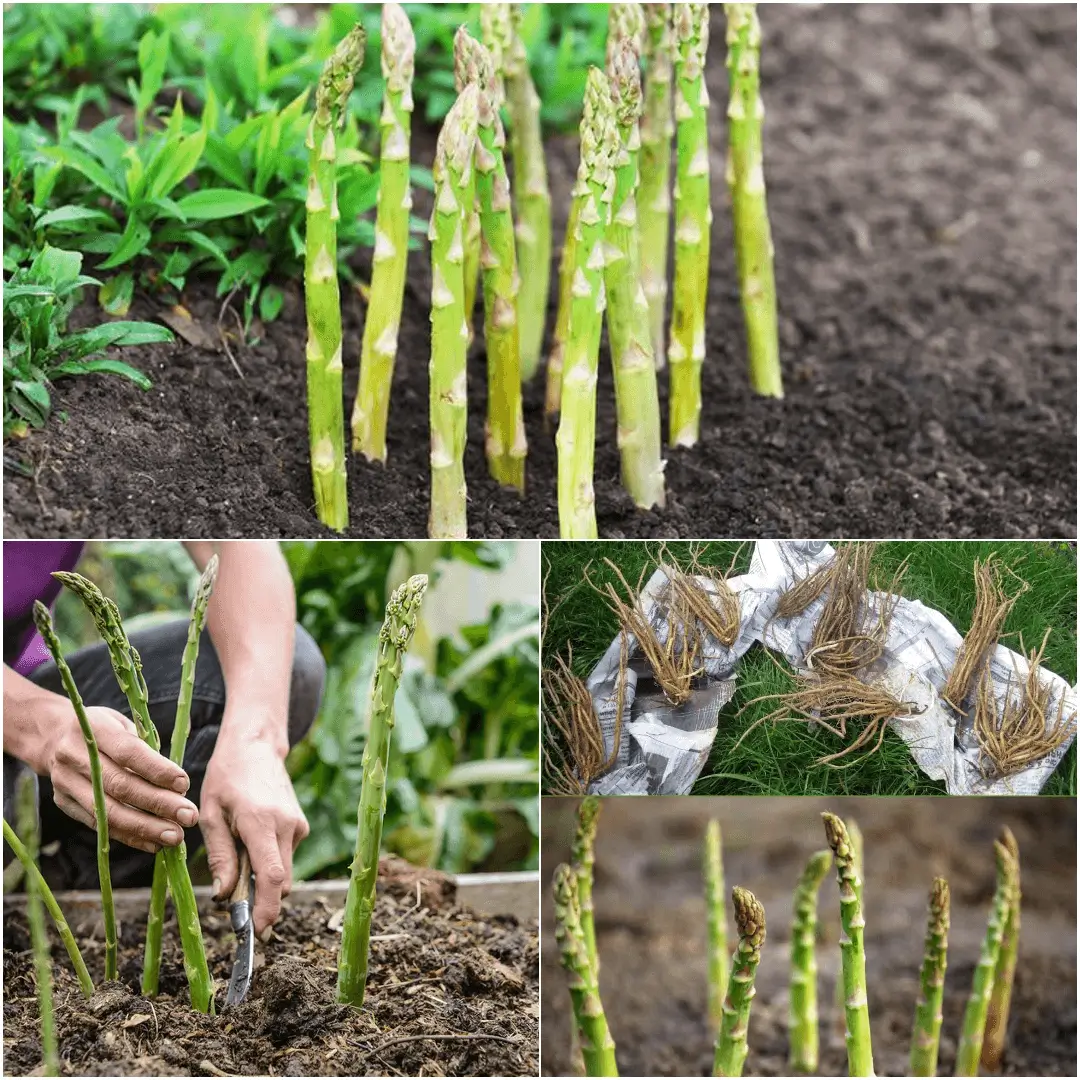Plant asparagus as a perennial vegetable that returns every year with a bounty of delicious, tender spears. Growing asparagus is a bit of a waiting game, but the payoff is worth it! In this guide, I’ll walk you through how to plant asparagus step-by-step, covering everything from choosing the best site to harvesting those first flavorful stalks. If you’re ready to start your own asparagus patch, let’s dig in!
Selecting the Best Planting Site
Choosing the right site for your asparagus is key to ensuring a healthy, productive bed for years to come.
Full Sun Exposure
Asparagus loves sunlight! Make sure to plant asparagus in a spot that gets at least 6 to 8 hours of direct sun daily. Lack of sunlight can stunt its growth, making it harder for the spears to develop properly.
Garden Bed Placement
Place your asparagus bed at the edge of your garden. Why? Because asparagus can grow undisturbed for 15 to 30 years! You want it out of the way of other annual crops so you don’t disrupt its long-term growth.
Ensuring Proper Drainage
Asparagus roots do not appreciate soggy soil. If your garden soil tends to stay wet or you have clay-heavy soil, consider planting your asparagus in raised beds. Good drainage helps prevent root rot, which can wipe out your plants.
Soil pH and Preparation
Asparagus thrives in soil that’s neutral to slightly acidic, with a pH of around 6.5. Before you plant asparagus, test your soil and adjust as needed. You can mix in compost, aged manure, or other organic matter to enrich the soil and ensure your plants get the nutrients they need.
Preparing the Soil
Eliminating Weeds
One of the most important pre-planting steps is to clear your planting area of all weeds. Weeds compete for nutrients and water, making it harder for your asparagus to thrive.
Loosening the Soil
You’ll need to dig deep! Loosen the soil to a depth of 12 to 15 inches. Asparagus roots grow long and deep, so providing ample room for them to spread will encourage strong plants.
Adding Organic Matter
Incorporating a 2- to 4-inch layer of compost, aged manure, or soil mix is essential to ensure your asparagus has plenty of nutrients to get started. This step sets the foundation for decades of productive growth.
When to Plant Asparagus
Ideal Planting Time
Asparagus crowns (those knobby root clusters) should be planted in early spring, just as the soil is workable—around the same time you plant potatoes. For many gardeners, this is the sweet spot for optimal growth.
Growing from Crowns vs. Seeds
Most asparagus is grown from 1-year-old crowns, but you can also start from seeds. If you’re starting with seeds, soak them in water for up to 24 hours before sowing to speed up germination. After about 12 to 14 weeks, the seedlings can be transplanted outdoors.
Soaking Seeds for Faster Germination
By soaking the seeds, you’re giving them a little jumpstart. Once they’re ready, you can plant them indoors, and after a few months, transplant them into your garden.
Step-by-Step Planting Process
Digging the Trench
To plant asparagus crowns, dig a trench about 12 to 18 inches wide and 6 to 8 inches deep. This will give your crowns enough room to establish themselves.
Placing the Crowns
Create a small ridge of soil along the center of the trench and spread the crowns out over it. This helps the roots spread out properly, making for a more stable plant.
Spacing and Watering the Crowns
Space the crowns 12 to 18 inches apart, then give them a good soak in lukewarm water before placing them in the trench. This helps hydrate the roots and jumpstarts the growing process.
Little-by-Little Planting Method
Gradual Soil Addition
Cover the crowns with 2 inches of soil to start. As the spears begin to grow, add another 2 inches of soil. Continue this process until the trench is filled to ground level.
Monitoring Spear Growth
Asparagus spears grow quickly, so keep an eye on them! Gradually filling the trench gives the roots time to adjust and develop strong systems.
All-at-Once Planting Method
Advantages of All-at-Once
If you prefer a quicker planting process, simply fill in the trench with soil and compost all at once. While it may not produce as strong of a root system as the little-by-little method, it’s still effective if you’re pressed for time.
Ensuring Loose Soil
Make sure the soil is loose enough for the spears to push through as they grow. This method works best in well-draining soil.
Mulching for Moisture and Weed Control
Choosing the Right Mulch
After planting, add a 4- to 6-inch layer of mulch. Straw, grass clippings, or compost work well to help retain moisture and keep weeds at bay.
How Mulch Helps Maintain Soil Quality
Mulch not only helps reduce the number of weeds but also helps the soil retain moisture, which is key for young asparagus plants to thrive.
Watering and Fertilizing Asparagus
Watering Requirements for Young Plants
During the first two years, asparagus plants need about 1 to 2 inches of water per square foot each week. If it’s dry, consider setting up drip irrigation to ensure consistent moisture.
Side-Dressing with Compost
Side-dress your asparagus with compost in the spring and fall to provide a steady supply of nutrients, which helps the plants establish a strong root system.
First-Year Care
Avoiding Harvest in Year One
Resist the temptation to harvest your asparagus in the first year. The plant needs time to establish itself, and cutting spears too early can weaken its root system.
Promoting Strong Root Growth
By not harvesting, you’re allowing the plant to focus its energy on root development. This patience will pay off with healthier, more productive plants in the long run.
Managing Weeds and Pests
Hand-Pulling Weeds
Asparagus roots are shallow, so avoid using tools that could disturb them. Hand-pulling is the safest way to keep weeds under control.
Managing Common Asparagus Pests
Keep an eye out for asparagus beetles and other pests. Regularly inspecting your plants and removing pests by hand can prevent significant damage.
Harvesting Asparagus
When to Start Harvesting
By the third year, your asparagus bed should be ready for its first harvest. The spears will be 8 to 10 inches tall and about 1/2 inch thick—perfect for picking!
How to Properly Harvest Spears
When harvesting asparagus, it’s important to use a sharp knife or garden shears to cut the spears cleanly. Cut the spears just below the soil surface or at ground level. Be careful not to damage any nearby emerging spears. You should aim to harvest spears that are about 8 to 10 inches tall and roughly 1/2 inch thick. For the first year of harvesting, limit the harvest period to 2 to 3 weeks. In subsequent years, you can extend it to around 6 to 8 weeks.
Maintaining Your Asparagus Bed Long-Term
Asparagus plants can live for 15 to 30 years if properly cared for, so keeping your bed healthy is vital.
Post-Harvest Care
Once the harvest period is over, allow the remaining spears to grow into ferns. These ferns play a crucial role in photosynthesis, storing energy for the next year’s growth. In the fall, after the ferns have turned yellow or brown, you can cut them back to ground level. This will help prevent diseases from overwintering in the ferns.
Replenishing Nutrients for Next Year
Each year after the harvest, side-dress your asparagus bed with compost or aged manure to replenish the nutrients in the soil. When you plant asparagus, you may also want to add a balanced fertilizer to encourage robust growth the following spring. Mulching with organic materials like straw or leaves helps keep the soil temperature steady and retains moisture.
Growing asparagus takes patience and a bit of hard work, but the reward of fresh, homegrown asparagus spears year after year is well worth the effort. By selecting the right site, preparing your soil carefully, and following proper steps to plant asparagus and maintain your plants, you’ll be on your way to a thriving asparagus bed. Remember to give your plants the time they need to establish strong roots, and you’ll be harvesting delicious spears for decades to come!
FAQs
What’s the best way to plant asparagus?
The best way to plant asparagus is to dig a trench 12-18 inches wide and 6-8 inches deep. Place the crowns on a small ridge of soil, spreading the roots evenly, then cover with soil gradually as the spears grow.
How long does asparagus take to grow?
Asparagus plants usually take about 3 years to reach full maturity and produce a good harvest. However, if you carefully plant asparagus, you can start harvesting a limited number of spears in the second year.
Does asparagus need full sun?
Yes, asparagus needs full sun to grow properly. When you plant asparagus, aim for 6-8 hours of direct sunlight daily to ensure healthy, productive plants.
How many asparagus do you get from one plant?
An established asparagus plant can produce about 20-25 spears per year, and with proper care, the plants can keep producing for up to 30 years. This makes it essential to plant asparagus in the right conditions to ensure a long-lasting and fruitful harvest.


